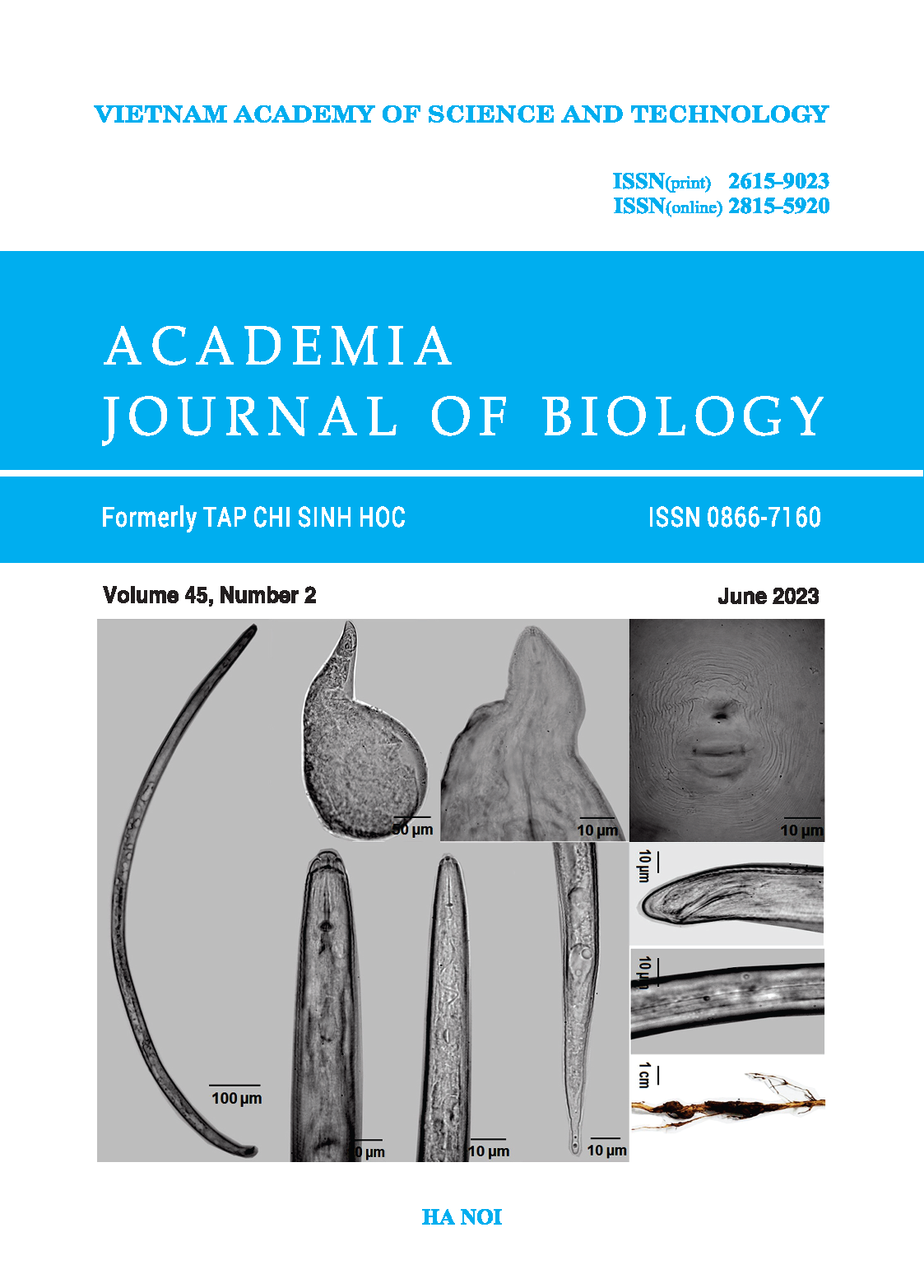Indigenous knowledge of poisonous plants from Van Kieu and Pa Ko ethnic groups in Quang Tri province, Vietnam
Author affiliations
DOI:
https://doi.org/10.15625/2615-9023/18142Keywords:
poisonous plant, indigenous knowledge, Van Kieu, Pa Ko, ethnic groupsAbstract
Poisonous plants are known for toxicity to humans and animals. They comprise a large group of plants in the world. This study aims to collect and systematically document the traditional knowledge of poisonous plants by interviewing Van Kieu and Pa Ko ethnic communities in Quang Tri province. A total of 56 poisonous plant species (27 herbs, 15 shrubs and 14 woody plants) of flowering plants belonging to 26 families and 50 genera were found in the study site. Based on the Recorded Poisonous Plant Proportion (RPPP) values, 25 commonly recorded poisonous plants were selected for analyzing Fidelity Level (FL) and Informants Consensus Factor (ICF). The ICF value of eye irritation, neurologic category, skin irritation, gastrointestinal category and respiratory/cardiovascular category was 0.97, 0.97, 0.96, 0.93 and 0.92, respectively. The most notable species (FL: 100%) in the gastrointestinal category were Ricinus communis L. and Millettia erythrocalyx Gagnep. In the respiratory/cardiovascular category, the most important species (FL: 100%) were Gelsemium elegans (Gardner & Champ.) Benth. and Strychnos vanprukii Craib. The presented results will provide fundamental information for further phytochemical and biological investigation to ascertain the toxic compounds of poisonous plants that may be used for the treatment of appropriate diseases.
Downloads
References
Anywar G., 2020. Poisonous Plants and Phytochemicals in Drug Discovery, Historical use of toxic plants. Wiley:
–17.
Completed results of the 2019 Viet Nam population and housing census, 2020. General statistical office. Statistical Publishing House, pp. 840.
Friedman J., Yaniv Z., Dafni A., Palewitch D., 1986. A preliminary classification of the healing potential of medicinal plants, based on a rational analysis of an ethnopharmacological field survey among Bedouins in the Negev desert. Israel Journal of Ethnopharmacology, 16(2–3): 275–287. https://doi.org/10.1016/0378-8741(86)90094-2
Huai H., Dong Q., Liu A., 2010. Ethnomedicinal Analysis of Toxic plants from five ethnic groups in China. Ethnobotany Jounal, 18: 1547–3465. https://ethnobotanyjournal.org/index.php/era/article/view/413
Huong Hoa Statistical Yearbook 2019, 2020. Huong Hoa statistical office, Statistical Publishing House, pp. 77 (In Vietnamese).
Lin H., Qiu H., Cheng Y., Liu M., Chen M., Que Y., Que W., 2021. Gelsemium elegans Benth: Chemical Components, Pharmacological Effects, and Toxicity Mechanisms. Molecules, 26(23): 7145–7154. doi: 10.3390/molecules26237145.
Moshiri M., Hamid F., Etemad L., 2016. Ricin Toxicity: Clinical and Molecular Aspects. Reports of Biochemistry and Molecular Biology, 4(2): 60–65. https://www.ncbi.nlm.nih.gov/pmc/articles/PMC4986263
Ninh Khac Ban, Phan Van Kiem, Ninh Khac Thanh Tung, 2022. Medicinal plants of Van Kieu and Pa Ko ethnic groups in Quang Tri province. Natural science and Technology Publishing, pp. 472 (In Vietnamese).
Panter K. E., Welch K. D., Gardner D. R., Lee S. T., Green B. T., Pfister J. A., Cook D., Davis T. Z., Stegelmeier B. L., 2012. Veterinary Toxicology, Poisonous plants of the United States. Oxford: Academic Press, pp. 1029–1079. https://doi.org/ 10.1016/B978-0-12-385926-6.00100-9
Serrano R., 2018. Toxic plants: Knowledge, medicinal uses and potential human health risks. Environment and Ecology Research, 6(5): 487–492. https://doi.org/10.13189/ eer.2018.060509
Trotter R.T., Logan M.H., 1986. Informant consensus: a new approach foridentifying
potentially effective medicinal plants, Plants in indigenous medicine and diet: biobehavioural approaches. Bedfort Hills. Redgrave Publishers, pp. 91–112.
Vickery M., 2010. Plant poisons: their occurrence, biochemistry and physiological properties. Science Progress, 93(2): 181–221. https://doi.org/10.3184/003685010X12729948220326
Wink M., 2010. Mode of action and toxicology of plant toxins and poisonous plants. Julius-Kühn-Archiv, 421: 93–112.
Downloads
Published
How to Cite
Issue
Section
License
Academia Journal of Biology (AJB) is an open-access and peer-reviewed journal. The articles published in the AJB are licensed under a Creative Commons Attribution-NonCommercial-NoDerivatives 4.0 International License (CC BY-NC-ND 4.0), which permits for immediate free access to the articles to read, download, copy, non-commercial use, distribution and reproduction in any medium, provided the work is properly cited (with a link to the formal publication through the relevant DOI), and without subscription charges or registration barriers. The full details of the CC BY-NC-ND 4.0 License are available at https://creativecommons.org/licenses/by-nc-nd/4.0/.












